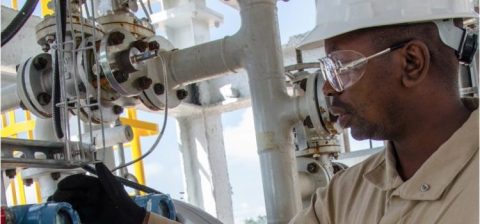
ExxonMobil start onderzoeksprogramma CO2-opslag
6 mei 2016 – ExxonMobil start, samen met FuelCell Energy, een onderzoeksprogramma voor CO2-afvang en -opslag (CCS). De nieuwe technologie die Exxon wil onderzoeken kan goedkoper en effectiever CO2 afvangen uit gasgestookte elektriciteitscentrales, verwacht het olieconcern.
ExxonMobil denkt dat de beste kansen voor grootschalige CCS bij gasgestookte elektriciteitscentrales liggen, aldus het bedrijf in een persbericht. Het olieconcern werkt met partner FuelCell Energy aan een nieuwe technologie, die tot nu toe alleen op laboratoriumschaal is getest. Het plan is om – als het onderzoek naar wens verloopt – in een jaar of twee een kleinschalig proefproject op te zetten, aldus de Financial Times.
De techniek komt er in het kort op neer dat de uitstoot van een gascentrale en aardgas in een brandstofcel worden ingevoerd. De chemische reactie zorgt voor geconcentreerde stoom waar de CO2 makkelijk uit te halen is. Bovendien genereert de reactie extra elektriciteit.
Een gasgestookte centrale met een capaciteit van 500 MW kan met de nieuwe CCS-technologie 120 MW extra opwekken, zo vermoedt ExxonMobil na eerder onderzoek. Ter vergelijking: de huidige technieken voor CO2-afvang en -opslag verlagen de capaciteit juist met 50 MW. Bovendien kan 90 procent van de CO2 van de gascentrale worden opgevangen, stelt ExxonMobil.
In het bericht stelt het bedrijf al een leidende rol te hebben in CCS. In 2015 sloeg ExxonMobil 6.9 miljoen ton CO2 op, aldus het persbericht. Intussen staat ExxonMobil niet bekend om zijn klimaatvriendelijke beleid. Sterker nog: in de Verenigde Staten loopt een gerechtelijk onderzoek naar ExxonMobil. Het bedrijf zou al sinds de jaren zeventig geweten hebben over de risico’s van klimaatverandering, maar het publiek daarover hebben misleid.

ExxonMobil over de technologie
‘(…) ExxonMobil’s scientists have been pursuing new technology that could reduce the costs associated with current CCS processes by increasing the amount of electricity a power plant produces while simultaneously delivering significant reductions in carbon dioxide emissions. At the center of ExxonMobil’s technology is a carbonate fuel cell.
Laboratory tests have demonstrated that the unique integration of carbonate fuel cells and natural gas power generation captures carbon dioxide more efficiently than current, conventional capture technology. During the conventional capture process, a chemical reacts with the carbon dioxide, extracting it from power plant exhaust. Steam is then used to release the carbon dioxide from the chemical – steam that would otherwise be used to move a turbine, thus decreasing the amount of power the turbine can generate.
Using fuel cells to capture carbon dioxide from power plants results in a more efficient separation of carbon dioxide from power plant exhaust, but with an increased output of electricity. Power plant exhaust is directed to the fuel cell, replacing air that is normally used in combination with natural gas during the fuel cell power generation process. As the fuel cell generates power, the carbon dioxide becomes more concentrated, allowing it to be more easily and affordably captured from the cell’s exhaust and stored. (…)’
Bronnen
ExxonMobil, 5 mei 2016: Advanced carbonate fuel-cell technology in carbon capture and sequestration
Financial Times, 5 mei 2016: Exxon launches carbon capture scheme (registratie)
FluxEnergie, 4 november 2015: ‘ExxonMobil misleidt publiek over risico’s klimaatverandering’



